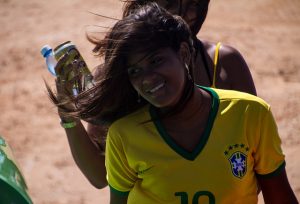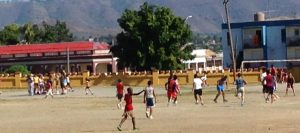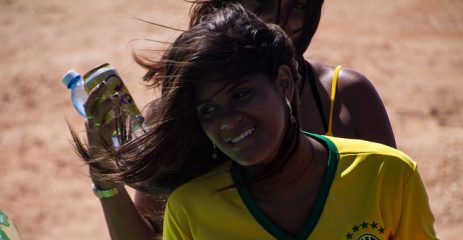 By Grant Jarvie and Alex Richmond
By Grant Jarvie and Alex Richmond
Sport for change is sometimes taken to mean sporting activities that are intentionally used to deliver social impact for individuals and communities beyond increasing participation or performance. The logic of Sport for Change needs a clear set of outcomes stating the intentional wider social impacts that intervention a, b or c aims to achieve. The ground is then cleared for initiatives that are focused upon producing change in areas such as health, education, community empowerment, justice, safety, enterprise, employability and much more.
 Accessing programmes for change through sport is complex and requires an understanding of groups, contexts and individual fears and barriers to participation.
Accessing programmes for change through sport is complex and requires an understanding of groups, contexts and individual fears and barriers to participation.
For example, Sport in Focus 1:1 provides an insight into some of the barriers facing some women from disadvantaged backgrounds aiming to access street soccer in one country.
SPORT IN FOCUS 1:1 Women’s Voices from the Street
Self-Selection
Quite often a lack of confidence can be a barrier to involvement in street soccer
- “I challenged myself by One- getting on the bus to come here to the other side of town and two – to discipline myself to come every week because it is only 6-weeks but that is a goal in itself”
- “It’s about balancing the stuff going on in your head and with some of the exercises deal with coordination- you can’t have that little voice in your head telling you you’re no good at it”
Fear of the unknown
Quite often fear of the unknown can be a barrier to involvement.
- “She used to do sport activities on a regular basis and she liked the community around them. So there is something to hold on to but it takes people some time to do it and believe they can do it”
- “…and going of my own experience- you’re like that sounds cool and I want to do it. But I don’t know what to expect. I don’t know what I am going into. Too many fears. Too many barriers holding me back….”
Football
Quiet often football is a barrier
- “I think that’s a difficult thing as I come from a generation where football just was not…”
- “…. that like me when I was a kid… I was the only one that played football… the rest of my friends didn’t play…”
- “That’s usually the first thing some say. If I speak to people, with girls about Street Soccer, they’ll say I can’t play football… I don’t know how to play football…”
Structural barriers
Quiet often the type of activity and the location of the activity can be a barrier
“…with temporary accommodation, it is usually around the city centre so it’s not an issue to get to places. But very often when people get Council housing they are outside, so coming into the city centre without having a bus pass or being on very limited benefits, that’s a barrier itself”
The practical lessons learned from change interventions are varied and context specific. Sport in Focus 1:2 provides an insight into some of these responses around three areas: Sport for Health; Sport for Social Inclusion and Sport for Conflict Resolution and Peace.
SPORT IN FOCUS 1:2 SPORT AND SOCIAL INTERVENTION
– Lessons to be passed on
Health
- “Our intervention taught us to always look beyond the obvious, that we set our goals from day one with community members and that we use our child protection policy and measurable activities to ensure that we are making positive differences in children’s lives.”
- “The power of parents, parents and dedicated community members are integral to creating community ownership of a health problem that has dramatic impact on their children’s wellbeing.”
- “The biggest practical lesson we have learned and already shared is the use of local talent who are hungry for opportunities to learn and succeed. As Rwanda is experiencing high levels of youth unemployment participants graduating from our programmes are in desperate need to support themselves and their families, retaining them within our programme has enabled us evolve, increasing the number and quality of services while at the same time supporting local communities and national goals for youth engagement”.
Social Inclusion
- “The single biggest learning is that the significant challenges faced by a programme and or organisation will have solutions, but you need to engage members and those involved to find solutions from within rather than look to external agencies for support. Believing in each other and providing the resources and tools primarily from within provides the platform from which sustainability is created”.
- “Our biggest single insight is local ownership of the programme which for us involves a blend of sport development and sport for development”.
- “We learned that volunteer coaches need more than just initial training but ongoing support to foster their development, confidence and effectiveness”
Conflict Resolution and Peace
- “A wide network, a willingness to be transparent and strong partnerships are vital” The ethos of sharing and partnership increases our ability to help refugee”
- “Young leaders who are free of the baggage that so many of this and the past generations carry with them are ideally placed to actively contribute to creating a more stable and peaceful society – in our context they are the fourth vital pillar of community relations”
- “Start small- because we started small and listened to the community we could identify strengths to build on like recognizing that many people believed in themselves”
- “While conflict resolution content is crucial high calibre competition is no less important- it helped us engage participants on a long-term basis – an essential factor in effecting meaningful positive change”
- “We have learned that success of our intervention in a conflict environment is dependent on long term activities that adapt to change on the ground. Long term programming is essential in order to support and gauge the gradual process of perception change among people and communities”
Sport for Change
While Sport for Change can be a resource of hope for many individuals, communities and groups, it should not be at the expense of recognizing the capabilities that are demonstrably delivered through sports participation or performance, nor should it be at the expense of the role of sport in voicing social alternatives, or being a critique of the triumph of capitalism.
 The humanitarian aspect of the Olympic movement should perhaps come more to the fore ahead of medals or hosting major sporting events that many cities and countries cannot afford.
The humanitarian aspect of the Olympic movement should perhaps come more to the fore ahead of medals or hosting major sporting events that many cities and countries cannot afford.
There is a substantial body of work that shows sporting mega events as adversarial sites and draws these into the politics of place and time. There needs to be at least a common narrative throughout these events if they are going to live up to the promise of the term social movement or a humanitarian resource of hope.
They certainly need an alternative to the neo-liberal narrative. Forms of activism around major sporting events invariably fall into categories such as spontaneous uprisings, grass-roots mobilisation and protest and special interest groups. Such events can act as soft power through arguing for transparency, accountability, local involvement and increased capability in community outreach with measured intentional social impacts.
Their needs to be more agreed common ground about sport for change and the language of sport for change where it is agreed that sporting initiatives unwittingly or otherwise should not produce harm while any divisions within sport about the language of sport needs to be inclusive and recognise that sporting factions are stronger together than apart. We should not underestimate the capacity of sport to collapse social barriers, nor should we ignore the lack of access to sport for youth living in poverty in many parts of the world. It is crucial to acknowledge the capacity of sport to facilitate social change.
The strength of sport’s capacity to produce change lies in its popularity in different parts of the world, its capacity to symbolise graphically but more poignantly work for social and political change, acknowledge success and learn the lessons from political failures through sport. Such alternatives both influence and are influenced by different visions of a world that continues to struggle with inequality, turmoil and lack of clarity about the nature of both capitalism and democracy. Contemporary researchers, teachers and thinkers about sport in the world today, and those working with sport are having an impact but more needs to be done.
Endnote
If those supporting sport for change move Beyond Sport as it is currently operating, invoke the idea of intentionality, maximise the social tool box that is sport then it might just be that an aspirational politics of the possible might be grasped if not realised.



